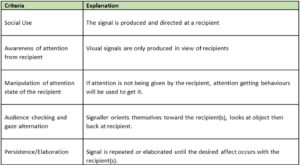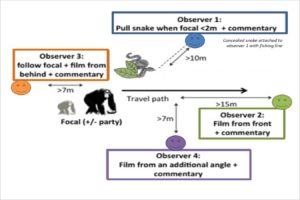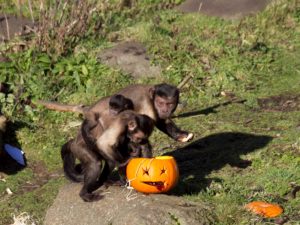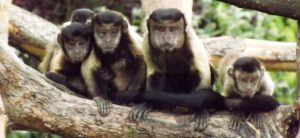Do Squirrel Monkeys Understand the Rules of Language?
The ability to learn patterns, ultimately the rules of language has rarely been studied in new world primates. In this study the researchers use species specific sounds/tones to determine if the squirrel monkeys were able to decipher when the correct order and incorrect order of these sounds were played. This is the first study that has used species specific frequencies in order to test their abilities. Other studies relied on humans producing syllables, which may not have been the most appropriate way to measure the monkeys’ capabilities.
Two ordered sound patterns were tested with the same rule being applied of A Bn A.
Test 1 – Low Tone= A, and High Tone = B (eg. Low, High, High, High, Low)
Test 2 – High Tone = A and Low Tone = B (eg. High, Low, Low, High)
The results suggest that the monkeys were able to consistently decipher when the rules were being broken in both the test settings.
These finding suggests that the ancestor of both squirrel monkeys and humans which existed approximately 36 million years ago would also have been able to understand the rules involved in pattern learning, thus most living apes and monkeys today should also be able to do this. This skill may have evolved as a cognitive ability rather than a direct pre-cursor to language.
Ravignani, A., Sonnweber, RS., Stobbe, N. and Fitch, TW (2013). Action at a distance: dependency sensitivity in a New World primate. Biology Letters. 9. 20130852
Ruth Sonnweber, one of the scientists from this study is now continuing similar work here with our squirrel monkeys in Living Links, however instead of sound stimuli she has been using touch screen to determine their ability to learn patterns.
Hey mate? There is a snake!
Chimpanzee Alarm Call Production Meets Key Criteria for Intentionality
Determining the intentionality of primate communication is vital to understanding the evolution of human language. Although intentional signalling has been studied for some great ape gestures, comparable evidence is currently lacking for their vocal signals.
In this study the following criteria were used to analyse if the Sonso group of chimpanzees in the Budongo Forest in Uganda were communicating with intention.
The researchers presented the chimpanzees with a python model with up to 4 observers recording the calls and behaviours of each focal individual.
Figure – The snake image represents the location of the python
model, concealed by leaves. Observers and their main roles are defined. The
chimpanzee image depicts the focal chimpanzee, who could be accompanied by
other group members depending on the experimental condition.
The results of this study indicate that some chimpanzee calls meet the criteria for intentionality, for example most chimpanzees who had seen the snake model gave calls and demonstrated gaze alternation and audience checking with a fellow chimpanzee. ‘Waa Barks’ (WB) and ‘Alarm Huus’(AH) were produced in the presence of socially important individuals who had not seen the snake. Furthermore , WB’s and AH’s were increased in the presence of friends vs. non-friends.
The researchers believe that their findings disagree with the gestural theories of language origins and instead support a multimodal origin for human language.
Video illustrating gaze alternation and looking at a group member before producing waa barks. Video is filmed from position 2. Focal adult female Nambi reacts to the arrival of her adult son Musa by turning and looking at Musa before producing her first waa barks of the trial. Nambi then looks immediately back at the snake, showing gaze alternation between the recipient and the snake whilst calling. During Nambi’s waa bark production, Musa stands bipedally.
Schel, AM., Townsend,SW.,Machanda, Z.,Zuberbuhler, K., and Slocombe, KE. (2013). Chimpanzee Alarm Call Production Meets Key Criteria for Intentionality. PLoS ONE 8 (10): DOI: 10.1371/journal.pone.0076674
Monkeying Around At Halloween
Keepers at the Living Links Centre have created special Halloween-themed enrichment for the monkeys; spooky pumpkins, paper mache balloons and ice lollies have been hung from the trees in the outdoor enclosures.
Sophie Pearson, Team Leader for Living Links and the Budongo Trail, said:
“All of the keepers have spent several days working on the Halloween surprise for our monkeys and we love coming up with new enrichment ideas for them to enjoy. We have made spooky faces on paper mache balloons and filled Halloween cups with frozen treats. They also don’t often get pumpkin so this will be an extra special surprise for them!
“Capuchins are very intelligent and inquisitive, with their own individual personalities, and it is great fun waiting to see how they will interact with the various activities or treats they receive. By hanging the enrichment in the trees, there is an added level of complexity, which will mean the capuchins will have to use their prehensile tails and excellent climbing skills to reach their treats.
“They are also quite destructive and simply love to pull things apart, just like little children.”
The Halloween enrichment will provide both mental and physical stimulation for the monkeys, as well as provide visitors with the opportunity to see the troupe display natural behaviours normally seen in the wild. The capuchins at Edinburgh Zoo regularly receive enrichment that utilises their problem solving skills and encourages team work within the complex social hierarchy.
Please Knock
Reliably signalling a startling husbandry event improves welfare of zoo-housed capuchins (Sapajus apella)
Kristina Rimpley and Prof Hannah Buchanan-Smith of Stirling University examined the effect of giving the capuchins a reliable signal (a knock on the door) 3 seconds prior to a keeper entering the enclosure to perform a husbandry event. The study hypothesised two main things;
1. That unreliable signals that indicate husbandry events may have a negative impact on capuchin behaviour.
2. Making a husbandry event predictable will decrease anxiety related behaviours prior to the husbandry event.
To address these hypotheses the researchers studied 12 of the capuchins at Living Links, 6 from the West and 6 from the East. Behaviours that were used as indicators for anxiety levels were scratch, vigilance and jerky motion.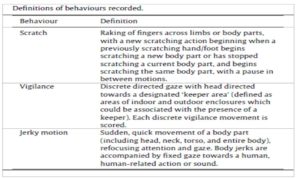
Baseline information was gathered on the monkeys’ behaviour 5 minutes before and after door events, with a door event being defined as the opening and/or closing of any door in the keeper area which could be heard by the capuchins.
As you will see in the figure above there are many doors in the keeper area and they may be opened or closed for a variety of reasons. Thus hearing a door could not predictably signal a keeper would enter a capuchin enclosure. In fact only 30% of door events resulted in a keeper entering a capuchin enclosure.
Therefore the researchers implemented the treatment of the door knock 3 seconds prior to a husbandry event to allow the capuchins a predictable indicator that a keeper was about to enter. The capuchins were given 2 weeks to get used to knocking as a signal then observed again to see if their anxiety levels had changed towards door events.
The results indicate that there was a decrease in anxiety related behaviours of the capuchins in the after door event in the treatment phase, thus supporting the notion that giving the animals a predictable indicator of events can benefit the overall welfare of the monkeys.
This is a great technique that can be implemented very easily for no cost and no additional time and can have a great benefit to all our monkeys’ well being.
Reference
Rimpley, K and Buchanan-Smith, H (2013). Reliably signalling a startling husbandry event improves welfare of zoo-housed capuchins (Sapajus apella). Applied Animal Behaviour Science. 147, 205-213.
Dr Jane Goodall, DBE receives honorary degree
Dr Jane Goodall and Hillary Clinton
Dr Jane Goodall DBE, who opened Living Links in 2008, was recently recognised by receiving an Honorary Degree of Doctor of Science by the University of St Andrews as part of its 600th Anniversary Celebrations. Other Honorary Graduands included Hillary Clinton, former USA Secretary of State, Sir Tim Berners-Lee, inventor of the World Wide Web, Lord Williams, former Archbishop of Canterbury, and Professor Mary Beard, Classicist. The laureation for Dr Goodall was given by the Director of Living Links, Professor Andrew Whiten, and the ceremony was also attended by Professor Chris West, RZSS CEO.
Honorary Graduands and Laureators of the Graduation Ceremony of 13th September 2013 marking the Academic Celebrations of the University of St Andrews’ 600th Anniversary. Front row, 3rd and4th from left: Dr Jane Goodall DBE, Ethologist and Conservationist, and laureator Professor Andrew Whiten.
Science Summer School 2013 – New Mums depend on each other
From July 29th to August 9th RZSS Edinburgh Zoo runs a Science Summer School for teenagers aged 16-18 yrs. It is a week long introductory course into zoo and wildlife sciences.
Last week some of our students were observing our two new mothers in the West enclosure. Both Santi and Lana have recently had babies. The students were investigating who the group would spend more time with. Lana (the alpha female) and her baby or Santi and her baby (the newer baby). They found that the two mothers spent the most time together and the rest of the group and Diego the alpha male spent equal amounts of time with both the mothers.
Our students concluded that this result is very similar to human mothers who like spend time together bonding over the daily gripes of raising babies.
Photo by : Kirsty Cheyne
Monkey business – It’s not what you know, but who you know!
Social networks shape monkey “culture”
A new study, published in Current Biology, shows that squirrel monkeys who are at the heart of their social group pick up innovations first, and are more likely to acquire new cultural variations in behaviour like novel foraging techniques.
Dr Nicolas Claidière, Ms Emily Messer and Professor Andrew Whiten of the University of St Andrews in collaboration with Dr Will Hoppitt of Anglia Ruskin University studied both our East and West squirrel monkeys. They examined their social networks by recording who spent time with whom when the monkeys were in the vicinity of an “artificial fruit” that could be used to obtain food rewards by using two different techniques, lift or pivot (Figure 1).
Sophisticated statistical analysis of this information revealed the details of the monkeys’ social networks which helped the researchers visualize which monkeys were at the heart of the network and which were more peripheral (Figure 2). Each monkey was rated on a measure of their ‘centrality’ within the group. 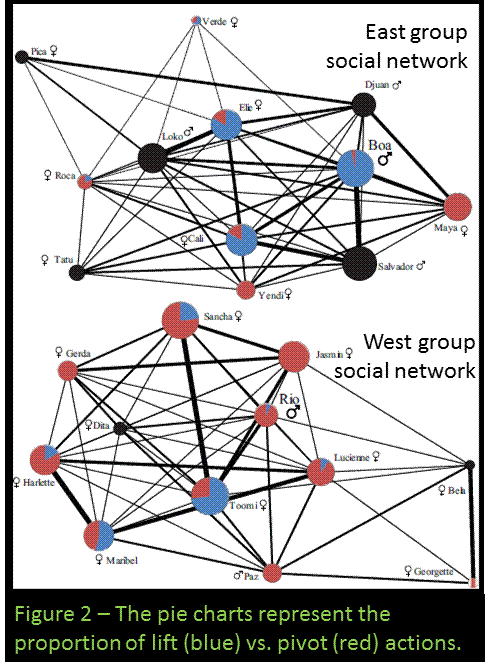
Boa the alpha male in the East group was briefly separated and trained how to use the lift technique and his equivalent, Rio in the West group was trained to use the pivot technique, they were then reunited with their respective groups.
The scientists found that monkeys who were well-connected were the most likely to successfully pick up the new technique seeded in their group. They were also more likely to acquire the lift technique in the group seeded with ‘lift’, versus the pivot technique in the group seeded with ‘pivot’, so the alpha males were truly the hubs of these two different monkey ‘cultures’.
Professor Whiten, from the University of St Andrews, said: “Our study shows that innovations do not just spread randomly in primate groups, but as in humans, are shaped by the monkeys’ social networks”.
Dr Claidiere said: “Research interest in social learning and social network analysis has surged in recent years, and our results are likely to stimulate further research on the spread of innovations in animal social networks.
“We suspect that our focus on a social network relevant to the diffusion of foraging innovations can explain why we found an effect of the network centrality of individuals on their learning.
“Previous research has focused on other relationships, like who grooms whom, which may not correlate with the monkeys’ observational learning in the same way”.
Emily Messer, noted another aspect of the study. “We also found that maternal relationships explained parts of the social network, so some of the diffusion of the new foraging habits were also probably reflecting an emphasis on learning within families,” she said.
Click here to lead you to the abstract of the article in Current Biology
Living Links to Life Long Learning – U3A Study Day
On the 5th of June, University of the Third Age (U3A) members from across Scotland came to their third annual study day here in Edinburgh Zoo. The theme for this year was Primatology.
With so many amazing projects happening at Budongo Trail and Living Links we felt this was an ideal opportunity for our researchers to engage with life-long learners.
The conference was set in the Budongo Trail Lecture Theatre and included a keynote speech from Professor Andy Whiten, presentations from our current PhD students, and Dr Katie Slocombe gave the delegates a live demonstration of how we study chimpanzee communication.
 Our guests also had a chance to explore the two enclosures with many of our staff,
Our guests also had a chance to explore the two enclosures with many of our staff,  volunteers and researchers on hand to answer questions.
volunteers and researchers on hand to answer questions.
Click here to see the full programme of the day’s events.
Linking to the Curriculum
On Friday April 26th we had 23 science teachers from over 15 different Scottish Secondary schools come to the zoo to take part in a teacher training day.
The day’s events included training with two of our resource packs, Measuring Behaviour and Chimpanzee and Human Chromosomes. In the chromosome activity the teachers had a chance to compare the differences and similarities in the chromosomes of humans and chimpanzees, these resources are ideal for teaching students about genetic deletions, mutations and inversions.
In the Measuring Behaviour workshop they received an overview of how to study primate behaviour then went out into the zoo to study our primates themselves.
We got some fantastic feedback from the day and the teachers are very excited to start using our resources in their classrooms. In the future we hope to offer another training day for our other two resource packs; Working with Scientific Literature and Primate Communication.




